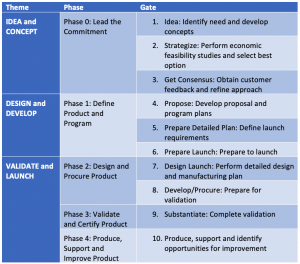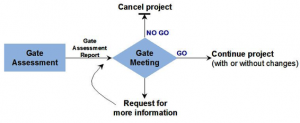New Product Development: Phase-Gate Process Introduction
The early establishment of a phase-gate process is critical for New Product Development (NPD) ensuring that only the most attractive projects move on in development. A method of this nature will enable the Product Team to maintain discipline and structure with the transition criteria from gate to gate are established before NPD Project Teams start developing real concepts from ideas.
“You’ve got to eat while you dream. You’ve got to deliver on short-range commitments, while you develop a long-range strategy and vision and implement it. Success is doing both; walking and chewing gum if you will, getting it done in the short-range and delivering a long-range plan, and executing on that.” Jack Welch
The Phase-Gate Process
The Phase-Gate process is a disciplined and upfront planning focused process to satisfy customer needs. It includes all methods from concept to maturity and collects business best practices from all business functions. NPD covers new markets, new products, new services, and product or service enhancements.
What is a “Phase”? What is a “Gate”? Phases are made up of activities and analysis that together create deliverables, and Gates are made up of deliverables and criteria which together create outputs.
Gated processes differ significantly from other innovation-related processes due to three attributes: they are focused on tough, iterative investment decisions, they are deliverable-centric, and they require a high degree of cross-functional coordination and communication.
The first six Phase-Gates provide the process and structure of planning, including ideation, strategy, internal consensus, feasibility, and a detailed launch plan, while Phase-Gates 7-10 focus on execution.

Gate-to-Gate
“However beautiful the strategy, you should occasionally look at the results.” Winston Churchill
The decision to move from one Gate to the next is a critical decision. The decision criteria to move from Gate-to-Gate and the incorporation of lessons learned from initial implementations must be incorporated into subsequent product developments. As the decision to progress from Gate-to-Gate, refinement of the process should consider the following:
- Risks and abatements
- Gate criteria
- Levels and qualifications of staffing
- Leadership visibility and team motivation
- Specific product/portfolio-related criteria
Of the Gates, numbers 1, 3, and 6 are the most critical, and at a minimum, the NPD TEAM should attend these Gate meetings. Why? These gates are the essential “go-no-go” gates, or “kill or go” gates. In addition to “kill or go,” prioritization of this project versus that, the pace at which the project may proceed, or to put the project on hold. Although you can make these decisions at any time in the process, a decision to “kill” a project earlier than later provides critical resources to other efforts and projects.

Team Structure
A New Product Development Team is a group of people with complementary and cross-functional skills, who are committed to a common purpose, a set of team performance goals and an approach for which they hold themselves mutually accountable. The structure of a successful Phase-Gate Process includes four layers:

They follow and use the Phase-Gate Process:
- Accept and modify goals/mission
- Identify applicable checklist items
- Conduct Phase-Gate Reviews
- Conduct risk analysis/abatement
- Create and present Scorecards
- Create Critical Path Schedules
- Use other appropriate Phase-Gate tools
Team Start-Up
Empowering a team is a proven and effective process focused on team speed, and success. The experience of many project failure and success stories tell us that a useful start is the first step to project success. Many teams struggle at startup with the definition of work scope and as a result languish taking unnecessary project risk and delay. The benefits of the approach include:
- Problem statement and mission is well defined
- Strategy, risk assessment/reduction is approved
- Product Team is empowered, and a consensus is achieved at Phase-Gate reviews
- Time to value is enhanced
- Foundation is laid for team success
From the start, as with all projects, the balance of schedule, cost, and work scope are critical. Imbalance in these elements is typical at the beginning, but give care to aligning these three elements with the needs of all stakeholders and available internal and external resources. Depending on the criticality of the project/product (implications to customer, market, profitability, and other appropriate metrics) external assistance may be necessary to augment the teams or to back-fill internal resources. By the end of Gate 3, these elements must be balanced. There are deliverables for each Phase and Gate, for each of the Teams, and the list of deliverables forms a “checklist.”
Critical Success Factors
The three critical success factors that assure the success of the process include:
- A Thorough Process:
-
- Milestones defined at Gates
- Gates contain checklist items that may be tailored for any project/process
- Applied with Discipline:
-
- Enforced via the Phase-Gate process
- Includes Design Reviews, Producibility Reviews, Test Reviews, Program Reviews, Cost Reviews, Customer Reviews, etc.
- Monitored via the Scorecard Review Process
- Uses proven tools which are essential to the success of the business (examples):
-
- Workshops
- Risk Management
- Quality Function Deployment (QFD)
- Phase-Gate Reviews
- Scorecards
- Critical Path Scheduling (CPS)
- Target Costing
- Team Oriented Problem Solving Using Six Sigma (DMAIC)
For more information on how to use Phase-Gates in New Product Development, contact us here for a complimentary consultation.

